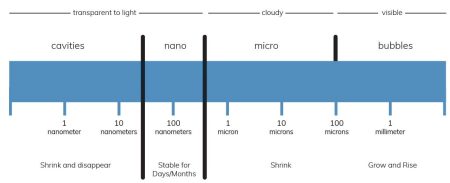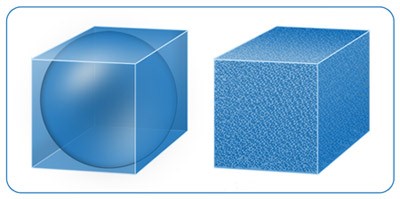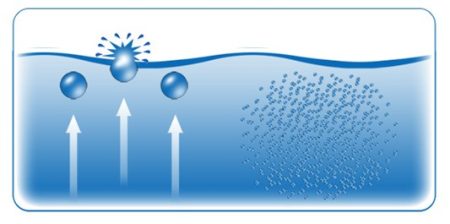Introduction
Besides changing the chemical properties of water, our unique electrolysis technology restructures the water by generating trillions of small bubbles into Aquaox solutions to deliver remarkable features that ordinary bubbles do not possess. Aquaox nanobubbles are electrically charged and stay suspended in liquids for months to accelerate the growth of plants, prevent biofilm and mineral scale formation, improve filtration, solubility, detergency, and lubricity properties of Aquaox solutions.
What Are Nanobubbles?
Nanobubbles are nanoscopic gaseous (typically air) cavities – ten thousand times smaller than a human hair – in aqueous solutions that can change the normal characteristics of water. Ordinary bubbles have a diameter that ranges from 1 µm and larger. These quickly rise to the surface of a liquid and collapse. Nanobubbles that are <100 nm in diameter will randomly drift and will remain in liquids for an extended period. How is electrochemically generated Hypochlorous Acid different?
How is electrochemically generated Hypochlorous Acid different?
Water that is processed through the Aquaox generator creates a dispersion of paramagnetic chlorine-oxygen nanobubbles, the presence of which gives the water highly functional properties that are not found in “normal” water. It is these characteristics that give electrochemically generated Hypochlorous Acid its unique properties that make it extremely effective.
Aquaox nanobubbles are tiny, long-lasting, HOCL-containing cavities in aqueous solutions. Aquaox generates nanobubbles with a particle size less than 100nm. Nanobubbles of this size are stable in Aquaox solutions. Their stability and size give them neutral buoyance and HOCL-containing bubbles remain suspended for an extended period without rising to the surface and off-gassing. Moreover, Aquaox nanobubbles have a strong negative surface charge which prevents the HOCL- nanobubble from coalescing.
 The longevity of HOCL-nanobubbles increases residence time of Oxygen and thus increases the amount of Oxygen present. When HOCL-nanobubbles are triggered, they destabilize and collapse releasing the Hydroxyl radical. The Hydroxyl radical (OH-) is a three-electron reduction product of molecular Oxygen and the most reactive species of oxygen. It is one of the strongest known oxidizers commonly used to destroy hard-to-kill pathogens, destabilize biofilms, and penetrate the smallest cavities in surfaces deeply removing all contaminants.
The longevity of HOCL-nanobubbles increases residence time of Oxygen and thus increases the amount of Oxygen present. When HOCL-nanobubbles are triggered, they destabilize and collapse releasing the Hydroxyl radical. The Hydroxyl radical (OH-) is a three-electron reduction product of molecular Oxygen and the most reactive species of oxygen. It is one of the strongest known oxidizers commonly used to destroy hard-to-kill pathogens, destabilize biofilms, and penetrate the smallest cavities in surfaces deeply removing all contaminants.

The presence of nanobubbles in Aquaox’ electrochemically generated Hypochlorous Acid has a number of benefits, including:
- Increased disinfection power: Nanobubbles carry HOCl molecules deeper into surfaces and objects, which help to kill more pathogens.
- Improved contact time: Nanobubbles increase the contact time between HOCl and pathogens, which also helps to kill more pathogens.
- Reduced toxicity: Nanobubbles reduce the toxicity of HOCl, which makes it safer to use in food processing and other applications.
- Enhanced penetration: Nanobubbles enhance the penetration of HOCl into porous materials, which help to kill pathogens that are difficult to reach.
- Prolonged shelf-life: Nanobubbles stay suspended and in dispersion preventing agglomeration, thus creating larger bubbles that off-gas to the surface. This helps to keep the HOCL stable and in suspension.
Studies with the same or similar conclusions
Multiple studies confirm the efficacy of nanobubble-based HOCl in killing a wide range of pathogens. They also suggest that nanobubble-based HOCl has potential applications in a variety of settings, including food processing, healthcare, and air purification.
One study that investigated the benefits of combining nanobubble technology with HOCl was published in the journal Food Control in 2016. The study found that nanobubble-based HOCl was able to kill 99.99% of Salmonella on chicken skin in just 1 minute. This is a significant improvement over the disinfection time of HOCl alone, which is typically around 3 minutes.
The study published in Food Control in 2016 concluded that nanobubble-based HOCl was effective in killing 99.99% of Salmonella on chicken skin in just 1 minute. This is a significant improvement over the disinfection time of HOCl alone, which is typically around 3 minutes.
The study published in Applied Microbiology and Biotechnology in 2018 concluded that nanobubble-based HOCl was effective in killing 99.99% of Listeria on lettuce in just 30 seconds. This is again a significant improvement over the disinfection time of HOCl alone, which is typically around 1 minute.
The study published in Water Research in 2019 concluded that nanobubble-based HOCl was effective in killing a wide range of waterborne pathogens, including Salmonella, Shigella, and Giardia. The study also found that nanobubble-based HOCl was more effective than traditional disinfection methods, such as chlorine and UV radiation.
The study published in Journal of Oral Microbiology in 2020 concluded that nanobubble-based HOCl was effective in killing oral bacteria that can cause infections. The study also found that nanobubble-based HOCl was safe to use in the mouth and did not cause any adverse side effects.
These are just a few of the many studies that have been conducted on the benefits of combining nanobubble technology with HOCl. The results of these studies confirm that Aquaox electrochemically generated nanobubble-based HOCl is superior to common chlorine mixtures that is successfully used to clean & disinfect surfaces and objects in a variety of settings, including food processing, water treatment, and healthcare.
Inside Aquaox SIO Nanobubble Generator:
For more information about Aquaox nanobubbles, click on the following links:
Https://aquaox.nl/applications/nanobubbles-aquaculture/
Https://aquaox.nl/applications/nanobubbles-horticulture/
For more documentation on Aquaox nanobubbles, download the following datasheets by clicking on the link below:
Aquaox brochure Aquaculture 2024
Aquaox brochure Horticulture 2024
Aquaox brochure Sanitation_CIP 2024
Aquaox- SIO Technology-Animal farming
Sources:
“A Comparative Study on the Efficacy of Hypochlorous Acid and Nanobubble-Mediated Hypochlorous Acid for the Disinfection of Food Contact Surfaces” (Food Science and Technology, 2018)
“Nanobubble-Mediated Hypochlorous Acid as a Potential Treatment for Wounds” (Journal of Wound Care, 2020)
“Nanobubble-Based Hypochlorous Acid for the Disinfection of Air” (Aerosol Science and Technology, 2021)

